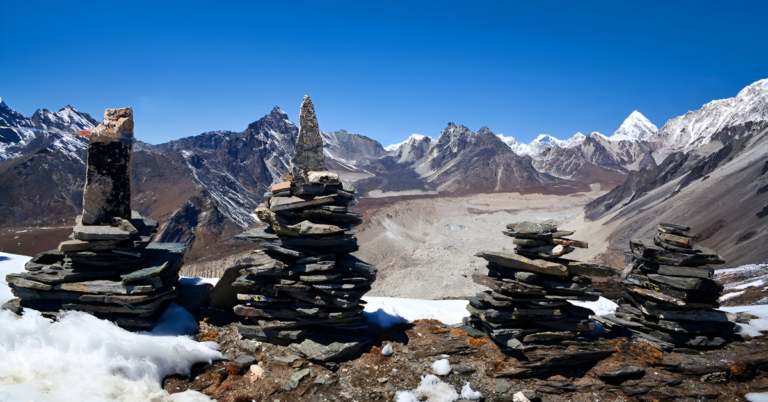Embarking on the Everest Three Pass Trek is an adventure of a lifetime, offering an exhilarating experience through some of the Khumbu region’s most iconic trails. Sharing paths with other treks like the Everest Base Camp trek and the Gokyo Valley trek, this route takes you across rocky trails, high mountain passes, and provides an intimate look into the life of the Sherpa communities who call these peaks home. The Everest Three Pass Trek combines physical endurance with cultural exploration, making it more than just a trek; it’s a journey through one of the most stunning regions on Earth.
Crossing the three famous high passes of the trek—Renjo La, Cho La, and Kongma La—requires both mental strength and physical resilience. This adventure isn’t just about conquering altitude; it’s a unique opportunity to connect deeply with the nature, history, and culture of the Everest region. For those looking to go beyond a typical trekking experience, this route delivers unparalleled challenges and rewards.
Everest Three Pass Trek Overview
The Everest Three Pass Trek is one of the most thrilling yet challenging treks in the world, designed for experienced adventurers. It traverses some of the most remote and rugged terrain in the Everest region, leading hikers across three major high-altitude passes: Renjo La, Cho La, and Kongma La. Each pass offers breathtaking views of the Himalayan landscape, making this route different from the traditional Everest Base Camp trek.
For those with a passion for exploration, this trek tests physical limits and demands mental resilience. Crossing these high passes isn’t just a physical feat but a journey into the heart of Nepal’s natural beauty and cultural heritage. This trek is ideal for those ready to take on a more challenging route in exchange for unmatched views and the true wilderness experience.
Importance of the Everest Region
The Everest region is one of the world’s most cherished destinations for trekkers and climbers. It is home to Mount Everest, the tallest peak on Earth, and holds great natural beauty and spiritual significance. The trek takes you through the Nepalese side of the mountain, known locally as Sagarmatha, allowing you to experience majestic peaks like Lhotse, Makalu, and Cho Oyu while gaining insights into the culture of the resilient Sherpa people.
Mount Everest, known as Sagarmatha in Nepali, is not just a mountain but a symbol of cultural and religious importance. It is sacred in both Buddhism and Hinduism, which elevates the significance of this journey. This trek offers a deeper connection to the spiritual and cultural heritage of the Everest region, making it more than just an adventure.
Overview of the Three Passes
The Three Passes—Renjo La (5,360 meters), Cho La (5,420 meters), and Kongma La (5,535 meters)—are the highlights of the Everest Three Pass Trek. Each pass presents a unique challenge due to its altitude, but all reward trekkers with stunning panoramas of Everest, Makalu, and other nearby peaks.
Starting with the ascent of Renjo La, trekkers are treated to views over the Gokyo Lakes, while Cho La involves a glacier crossing, adding an extra layer of adventure. Finally, Kongma La, the highest of the three, offers panoramic views of the Khumbu Glacier and surrounding mountains. These passes not only provide awe-inspiring vistas but also serve as milestones in a physically demanding yet unforgettable journey.
Trekking Trails and Highlights
Without a doubt, the Everest Base Camp Trek is one of the most exhilarating and thrilling treks available, taking adventurous trekkers to the heart of the Everest region via three epic high mountain passes that sit just out of reach from many climbing expeditions. The Three Pass Trek offers a more adventurous and challenging route, leading trekkers off the beaten path through three high-altitude passes—Renjo La, Cho La, and Kongma La—which reveal spectacular vistas of the massive Himalayan scenery, unlike the traditional Everest Base Camp trek. This journey is ideal for experienced trekkers seeking an adventure and immersive challenge as it tests physical endurance and mental tenacity!
Safety Measures and Contingency Planning
Safety is paramount on the Everest Three Pass Trek due to the high altitude and challenging terrain. Trekking above 3,000 meters requires careful acclimatization to avoid altitude sickness, which can escalate into severe conditions like High Altitude Pulmonary Edema (HAPE) or High Altitude Cerebral Edema (HACE).
To minimize risks, trekkers should progress gradually, stay hydrated, and monitor their physical condition. Trekking with experienced guides and porters familiar with the terrain is essential for handling emergencies. Bringing a satellite phone or having access to reliable communication tools is also crucial, as evacuation from remote areas can be challenging. Comprehensive travel insurance covering high-altitude trekking is a necessary safety precaution.
Concluding the Everest Three Pass Trek Experience
The Everest Three Pass Trek is a journey that combines physical challenges with cultural immersion and unparalleled natural beauty. Conquering the Renjo La, Cho La, and Kongma La passes offers adventurers a profound sense of achievement, alongside breathtaking views of Everest, Makalu, and the surrounding peaks.
This trek is more than just a hike; it’s a transformative experience that brings trekkers closer to the Sherpa way of life and the majestic Himalayas. The effort, endurance, and resilience required to complete this journey are rewarded with a deeper connection to one of the world’s most iconic regions. For those ready to take on this extraordinary challenge, the Everest Three Pass Trek promises memories and experiences that will last a lifetime.
